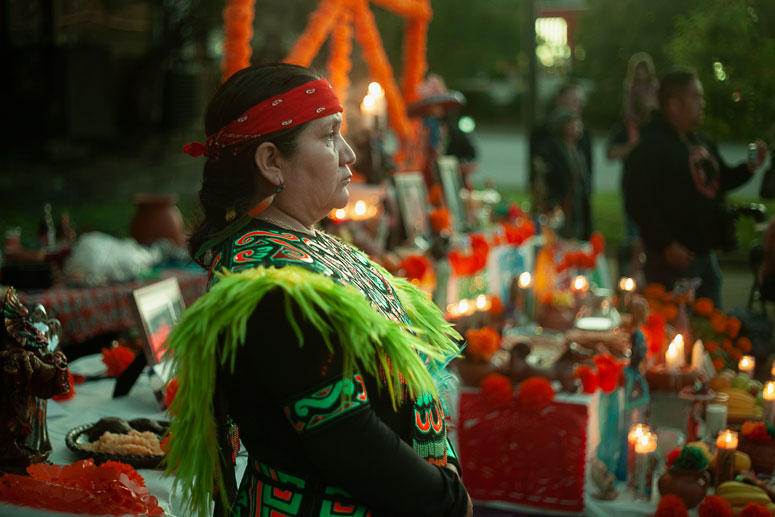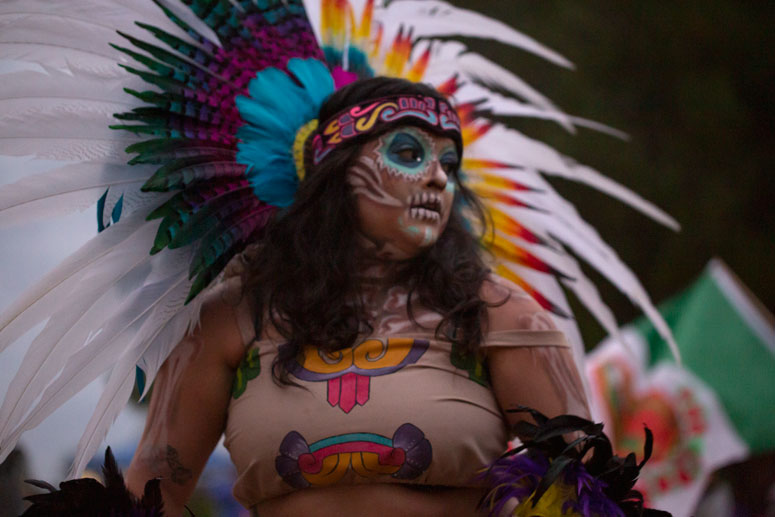Danza Azteca provides its participants access to embodied recuperations of indigenous epistemologies. Contemporary danzantes express their indigeneity through an aesthetic that includes traditional forms of dress and body adornment through the use of Aztec dance regalia and even tattoos and piercings. By wearing and tattooing Mesoamerican images, glyphs, and symbols, danzantes are reviving and preserving Mesoamerican art, including symbolic representations and expressions of religious philosophies. The practicing of Danza Azteca and taking on an indigenous aesthetic through dress and body adornment are a testament to the empowering role that spiritual traditions and artistic expressions have on the formation of a migrant political consciousness and indigenous identity in the diaspora.
Huerta (2009) proposes that the embodied knowledge of Danza Azteca provides important spaces for community building and personal identification (11). Following these arguments, one can better understand how, according to Huerta, the performative aspects of danza allow for corporeal articulations of oppositional consciousness and potentially, although not necessarily, for progressive politics within individuals and among the group as a collective entity (16).
La Danza Azteca permite a los danzantes encarnar epistemologías indígenas. Los bailarines contemporáneos expresan su indigeneidad a través de una estética que incluye formas tradicionales de vestimenta y adornos corporales mediante el uso de atuendos de danza azteca e incluso tatuajes y perforaciones. Al usar y tatuar imágenes, glifos y símbolos mesoamericanos, los danzantes están reviviendo y preservando el arte mesoamericano, incluidas las representaciones simbólicas y las expresiones de las filosofías religiosas. La práctica de Danza Azteca y la adopción de una estética indígena a través de la vestimenta y el adorno corporal son un testimonio del papel de empoderamiento que tienen las tradiciones espirituales y las expresiones artísticas en la formación de una conciencia política migrante y una identidad indígena en la diáspora.
Huerta (2009) propone que el conocimiento corporeizado de Danza Azteca proporciona espacios importantes para la construcción de comunidad y la identificación personal (11). Siguiendo estos argumentos, se puede comprender mejor cómo, según Huerta, los aspectos performativos de la danza permiten articulaciones corpóreas de conciencia opuesta y potencialmente, aunque no necesariamente, para una política identitaria y progresista dentro de los individuos y entre el grupo como una entidad colectiva (16).
Día de Muertos Festival, Durham NC
Every year for the past 10 years activist and cultural organizer, Yolanda Zavala, organizes a Día de Muertos festival honoring her sister who passed away 11 years ago, and whose birthday fell on Nov. 2nd. Dozens of Aztec Dance groups participate in the festival, which for organizers represents an important connection to their ancestors and cultural roots, and also serves as a space for healing and community building where families can gather to lay a flower on the symbolic graves of their ancestors -as many are unable to travel the thousands of miles home to visit the cemetery where their loved ones are buried as is tradition on Día de Muertos.
Por los últimos diez años, la activista y organizadora cultural Yolanda Zavala ha organizado un festival del Día de Muertos en honor a su hermana, quien falleció hace 11 años y cuyo cumpleaños era el 2 de noviembre. Decenas de grupos de Danza Azteca participan en el festival, que para los organizadores representa una conexión importante con sus ancestros y raíces culturales. Además, sirve como un espacio de sanación y construcción de comunidad donde las familias pueden reunirse para ofrecer una flor en las tumbas simbólicas de sus ancestros -ya que muchos no pueden viajar las grandes distancias a sus hogares para visitar el cementerio donde sus seres queridos están enterrados, como es tradición en el Día de Muertos.
*Huerta, Elisa D. “Embodied Recuperations: Performance, Indigeneity, and Danza Azteca.” Dancing Across Borders: Danza Y Bailes Mexicanos. Urbana and Chicago: University of Illinois, 2009. 3-18. Print.

Allan Pereira, a member of the Guerreros Quetzalcoatl dance group, performs sounds with the Teksispitsali (Nahuatl ) caracol marino or Caracola, a musical instrument used in ceremonies to invoke or ask permission from the winds.
Allan Pereira, miembro del grupo de danza Guerreros Quetzalcoatl, ejecuta sonidos con el Teksispitsali (nahuatl ) caracol marino o Caracola, instrumento de música usado en ceremonias para invocar o pedir permiso a los vientos.
Pedro Reyes, a young man of Mexican origin who practices the “Aztec Dance”, prepares his clothing before a presentation for the Day of the Dead, in the city of Durham, NC, on November 2, 2021.
Pedro Reyes, joven de origen Mexicano que practica la “Danza Azteca”, prepara su indumentaria antes de una presentación para el día de muertos, en la ciudad de Durham, el 2 de noviembre de 2021.

Yolanda Zavala, an activist with the Comité Popular Somos Raleigh and organizer of an annual Día de Muertos festival in Durham, NC, welcomes dancers to the space with ritual incense.
Yolanda Zavala, activista del Comité Popular Somos Raleigh y organizadora de un festival anual del Día de Muertos en Durham, da la bienvenida a los bailarines al espacio con incienso ritual.

In Aztec Thought and Culture, Miguel León-Portilla (1990) includes a Nahuatl passage that speaks of body adornments as works an artist might create: Perhaps a neighbor with a pendant hanging from his nose, his nostrils pierced, and a dart in his cheek, his body tattooed with little obsidian knives; thus the charcoal was fashioned, was carved and polished…whatever an artist makes is an image of reality; he seeks its true appearance (Aztec Thought 174). The Nahua believed that only those who came under the “divine influence which scatters flowers and songs among men is able to speak of truth on earth” (León-Portilla, Aztec Thought 169). If we consider the Nahua’s notion of art as being a representation of truth and the divine, then it must follow that body art was also considered to be divine.
*León-Portilla, Miguel. Aztec Thought and Culture: a Study of the Ancient Nahuatl Mind. Vol. 67. Norman: University of Oklahoma, 1990.


Pedro, member of the “Aztec Dance” group Danza Guerreros Quetzalcoatl, during a presentation for “Día de Muertos”, Durham, NC, on November 2, 2021.
Pedro Reyes, miembro del grupo Danza Guerreros Quetzalcoatl, durante una presentación para el “Día de Muertos”, Durham, NC, 2 de noviembre de 2021.
